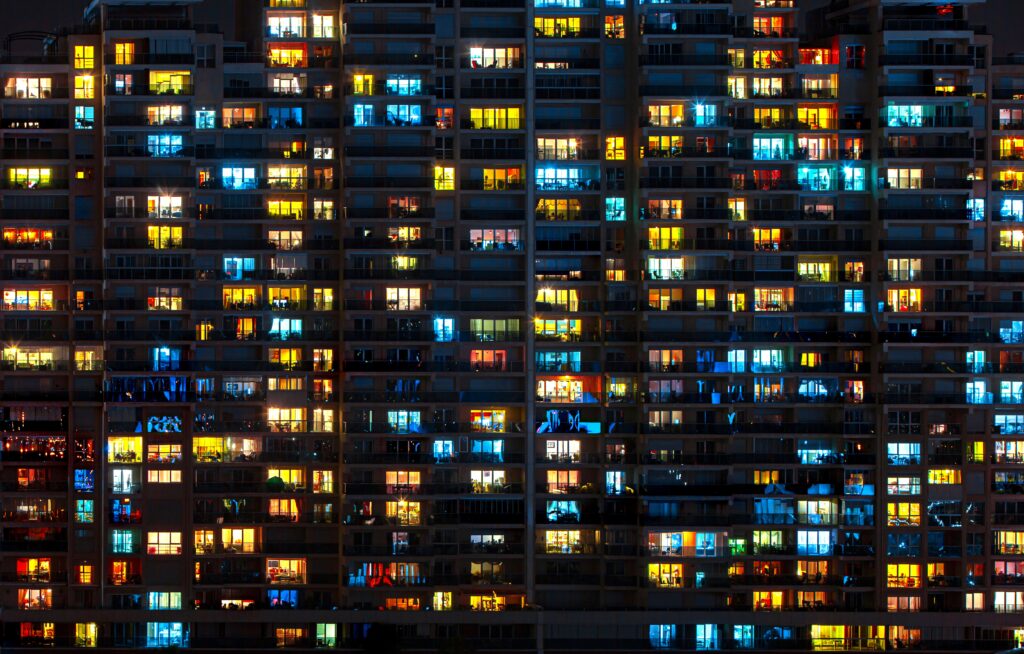In recent decades, commercial buildings have been the major focus of sustainability initiatives in Australia and New Zealand, but there are opportunities to apply this same focus to the increasing number of high rise residential buildings in both countries.

By Michael Fisher, Managing Director, Boon Edam Australia
But first, some compelling statistics and trends that underpin comments that follow about the major potential for energy savings in residential high-rise, which can start right at their front door.
More than 550,000 people now live in Australia’s 370,000 high-rise apartments located in buildings of nine floors or more. More than 2.5 million people, or one in 10 of us, now lives in an apartment. Similar trends are spreading south from Auckland in New Zealand.
And while the average population density in this Wide Brown Land of poet Dorthea Mackellar is still only 3.4 per sq kilometre, the figures from the latest Australian Census point us to strong growth in higher density lifestyles in the major urban centres where most of us live.
Of the approximately 11 million Australian private households out there, townhouses now comprise 13 per cent and apartments 16 per cent. The proportion of apartments continues to increase, with apartments accounting for nearly one third of the increase in private dwellings in the five years prior to the Census, reaching 30.9 per cent of construction. Similar trends are emerging in NZ, where of the 50,000 new dwellings for which approvals were given, those were 28,364 multi-unit homes, including townhouses, apartments, flats, and retirement village units, a 24% increase on the previous year.
Vertical living
So it is probably no surprise to architects, builders, and facility managers to see community leaders such as NSW Premier Chris Minns saying we need more vertical living to help end urban sprawl with a shift to more medium and high-rise housing. “We have to get more comfortable with the idea of going up,” he told this year’s Sydney 2050 Summit.
His comments reflect urgent social needs, in terms of creating a better supply of more affordable housing in areas where more people want to live. And given that this trend to high-rise is inevitable, it is timely also to look at the costs of living in these taller buildings.
Because there are many opportunities to be grasped in terms of major ongoing inputs to such structures, such as energy, to ensure the long-term sustainability and affordability of our ever-upwards urban environment.
So it’s time to look not only at the clean/green credentials of our one million approx. commercial (or non-residential) buildings, but also to take from them some of the valuable lessons we are learning there and see where they might also fit high-rise residential.
It is on Australasia’s commercial buildings (spanning the gamut from office towers and industrial buildings, through to shopping centres, age care and health facilities) where much of the green star sustainability focus has rested over the last decade or so.
Green star commercial buildings, increasingly, are designed and built to perform to the higher standards expected of “tight” buildings (ie, those that don’t have expensively heated or cooled air rushing in and out every time a door, window or building leaks to the environment, in the way that “looser” older buildings do).
High standards are essential in our commercial buildings if we are to reach our climate change goal of Net Zero by 2050, because commercial buildings account for nearly a quarter of national electricity consumption. And HVAC costs in such buildings typically account for nearly 40 per cent of such buildings’ energy use.
In response, there have been widely understood commercial energy-saving advances. These include engineering and technology improvements such as in in the efficiency of HVAC technology, in variable speed pumps and drives services, through heat exchangers transferring heat from systems where it is not needed to other systems where it can be usefully used, through automation of lighting and services, and through energy-saving lift technologies (between about 4% and 10% of a building’s energy is consumed by its lifts). Macro design and construction concepts include ‘tighter” buildings curtailing energy losses, plus building configurations and orientation to welcome natural light while excluding energy-sapping heat or cold, depending on the season and location.
Energy saving starts at the front door
Boon Edam’s particular contribution to the broader mosaic of energy conservation is the provision of architectural revolving doors, in which Boon Edam has been a world leader for 150 years. Our installations by Boon Edam Australia extend across the climate spectrum, from the souths of New Zealand and Australia, up to the topics of the Top End and of Papua New Guinea.
It is widely understood – and now validated by scientific measurement – that architectural revolving doors can curtail the current broad practice in Australasia of throwing ongoing energy savings out the front door by using cheaper and permanently less efficient entrances and exits.
With their always open/always closed functionality, revolving doors are one of the most immediate ways to help achieve energy use reductions in multi-story buildings by making them “tighter” and curtailing energy losses.
Until now, the difficulty has been proving and quantifying the gains – even though these ubiquitous door save energy from day one of installation by immediately preventing large quantities of prevent expensively cooled and heated conditioned air that would otherwise escape from the building through wide open doors of entrances and lobbies. We also know losses occur and through what is often described as the “Chimney Effect’ in taller buildings.
Architects, builders, and engineers tell us this “chimney” or “stack” effect occurs when the building’s HVAC system heats the warm air inside, which rises as the buoyancy increases, and creates a pressure differential, with a lower pressure at the base of the building. When a swing or sliding door is opening at ground level, it causes an inrush of air that forces heated air at the top of the building – a big issue in cooler months in all Australian and NZ cities.
The same pressure shift occurs in reverse in the warmer months generally, and in warmer climates particularly, as cooler air sinks through the building in the opposite direction, to tip expensively processed air onto the footpath.
But while architects and builders often scientifically and intuitively understand the benefits of revolving doors in general, it is often difficult to measure and quantify to their clients for individual buildings.
I stress measurable, because we are aware that many designers and builders have known intuitively for years about the opportunities revolving doors present – but didn’t have the figures to back up the ROI case for particular buildings on which they may be engaged. So quite often the client may go for the cheapest option up front, sometimes sliding or hinged doors that leak HVAC (and money) from the moment they are installed.
So we at Boon Edam have addressed the need for credible measure of the savings offered by revolving doors with software developed in partnership with one of the world’s leading technical universities.
A first in measuring energy use reductions
Delft University of Technology (TU Delft) – ranked in the top 10 engineering and technology best universities in the world by the globally respected QS rankings – partnered with Boon Edam to develop the Revolving Door Energy Saving Tool (REST), an energy saving calculation software.
Read the full article on this pioneering energy saving software.
“
It is widely understood – and now validated by scientific measurement – that architectural revolving doors can curtail the current broad practice in Australasia of throwing ongoing energy savings out the front door by using temporarily cheaper and permanently less efficient entrances and exits.
”
– Michael Fisher, Managing Director, Boon Edam Australia
These savings are particularly evident in high-rise, but also important in lower density buildings where stable temperatures are important (hospital and age care, for example).
The software removes a major impediment to architects, builders and building managers who may have wanted to use revolving doors, but lacked the figures to back up their case for doing so. As a result, the relatively simple and ongoing energy efficiencies of revolving doors may have been overlooked, or under-appreciated.
This is no longer the case. For both residential and commercial building specifiers seeking to achieve green performance ratings, it can now no longer be a question of ‘What is the cheapest door up front?’. Rather, the smart building equations becomes ‘How can we create a sustainable, secure, and comfortable environment that meets national and global standards of sustainability and returns benefits starting immediately and extending over decades?
In saying this, we don’t claim revolving doors alone are a silver bullet for energy conservation, because that is a multi-faceted question with a mosaic of solutions.
But the fact that we can now scientifically measure energy savings achievable with revolving doors makes it ever-more apparent that their performance is too good to ignore – both in for commercial buildings today, and for residential high-rise as it inevitably gathers pace.
Our choice really is whether we take advantage of these proven energy savings immediately, and in terms of rapid ROI – or we continue to throw them out the door to save small money today and post the big energy bill to owners, managers, and tenants tomorrow.
With work environments becoming increasingly global and dynamic, smart, safe entry has become the centre of activity in and around many buildings. Royal Boon Edam is a global market leader in reliable entry solutions, operating in 27 countries. Headquartered in the Netherlands, with 150 years of experience in engineering quality, we have gained extensive expertise in managing the transit of people through office buildings, airports, healthcare facilities, hotels, and many other types of buildings. We are focussed on providing an optimal, sustainable experience for our clients and their clients. By working together with you, our client, we help determine the exact requirements for the entry point in and around your building.
Please take a look at our range of revolving doors, security doors & portals, speed gates, tripod turnstiles, access gates and full height turnstiles to ensure the security of your entry and perimeter.
You can find more news about Boon Edam on www.boonedam.com.au/news


